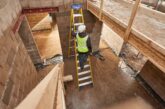
In the latest article by WernerCo, product manager Jamie Brassington discusses the health and safety and practical considerations surrounding choosing the right access equipment for the job.
Historically, there has been some confusion around whether the Health and Safety Executive (HSE) actually banned the use of ladders on site, something it later clarified. Its guidance states that ladders and stepladders can be a sensible and practical option, but stipulates that they aren’t suitable for all types of work on site.
Here we explore how access equipment can be chosen and used safely to minimise risks to you and other workers on site.
Falls from height remain the leading cause of workplace injuries, so employers and tradesmen can take some simple steps to prevent accidents on site, including by ensuring that the ladder is the right size and material for the job.
While understanding the various standards in place for access equipment can be somewhat of a minefield, it is vital that the ladder you choose meets the right standards and is suitable for professional use. When a ladder is used day in and day out on site it needs to suitable for purpose, that’s why at WernerCo our ladders are cycle tested over 50,000 so users can be confident they meet professional standards.
The material of the ladder should also be taken into consideration. For example, fibreglass ladders are great for working around electricity as they are non-conductive, which means reduces the risk of shock. Also, they are a robust, durable option, which offers a high resistance to denting and twisting meaning the safety of the ladder isn’t compromised.
It is important before undertaking any work at height that your equipment isn’t damaged in any way as this could affect the safety of the product. Carrying out a quick few minute check is always recommended to ensure ladders with missing, damaged or loose components are not used. Before use, ensure all working parts move properly and that all connections are secure, being mindful to carefully check spreaders, treads, ropes and safety feet.
If you’re happy that the ladder or stepladder is safe to use, some additional precautions can protect you when working at height. The Work at Height Regulations prohibits overstretching or standing above the recommended working height of the ladder, which is one of the common causes of accidents on site. Most ladders will include a label to indicate the safe working height and it is crucial that work isn’t carried out above this level. With that in mind, it’s recommended to have a range of different types of ladder in your toolkit – from a step ladder to a stairwell solution – with various working heights so you can ensure you’re prepared for any job.
Ladder time limits
Ladders aren’t always the most appropriate solution when working at height. Going back to the HSE’s guidelines, it recommends working on a ladder for no longer than 30 minutes. If you need to work at height for longer make sure you take regular breaks or consider alternative work at height equipment such as an Access Tower.
Access towers are a reliable alternative to permanent scaffolding, and all come with an inbuilt guardrail to prevent falls. As well as being portable, access towers are in most cases quick and easy to erect, offering safe working heights of up to 14m internally and 10m externally.
Alternatively, Fall Protection Kits are another way to keep you safe on site. When selecting a fall protection kit, you should always look to source from a trusted brand or manufacturer to guarantee the integrity of the equipment provided. These can be used for everything including roof access on domestic buildings to work on construction sites.
When purchasing any fall protection kit that includes a safety harness, you should make sure it is certified to the correct standard to guarantee safety. Any fall protection system should be CE marked to guarantee safety, while full body harnesses should be certified to EN 361:2002.
If you are unsure on which type of access equipment is appropriate for the job, the Work at Height Access Equipment Information Toolkit (WAIT) is a free online resource that provides details of some of the most common types of access equipment and where its use is most appropriate.
Alternatively, Werner also provides a comprehensive training programme approved by the Ladder Association, which is designed to help users choose the right ladder and ensure correct usage.
![]()







